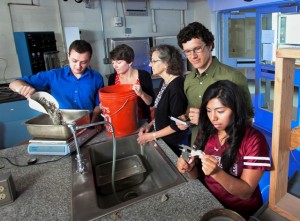A fraction of dust seven times smaller in diameter than an average human hair can cause significant consequences both to the environment and human health. The EPA classifies the dust, known as PM10, as a key air pollutant and identifies travel along unpaved roads as the largest anthropogenic source of PM10.

Brian Skalla ’16, Hailey Votta ’15, Professor Laurie Caslake, Professor Michael McGuire, and Erika Hernandez ’17 work with the dust measuring apparatus in Acopian Engineering Center.
An interdisciplinary research team is evaluating its hypothesis that an algae-based biofilm could be a biodegradable treatment for unpaved roads. Biology major Erika Hernandez ’17 (Arlington, Texas) and civil engineering majors Hailey Votta ’15 (Levittown, New York) and Brian Skalla ’16 (Sparta, New Jersey) are working with Michael McGuire, assistant professor of civil and environmental engineering, and Laurie Caslake, associate professor and assistant head of biology, through Lafayette’s EXCEL Scholars undergraduate research program.
They are collaborating with Oregon State University’s College of Forestry on a proposal for National Science Foundation (NSF) funding to study stabilization of unpaved roads using biologically derived materials.
McGuire explains that there are nearly 1.4 million miles of unpaved road nationwide (about 35 percent of all road mileage). When the moisture level within an untreated gravel road drops low enough, mechanical disturbances and air currents from passing vehicles create dust clouds that include PM10. The pollutant can contribute to heart disease, asthma, emphysema, chronic bronchitis, and chronic obstructive pulmonary disease. It also increases surface water turbidity and creates a light-blocking coating on vegetation.
Solutions include treating unpaved roadways with water, which evaporates quickly, or the application of a salt-, petroleum-, or plant oil-based solution, all of which can be harmful to the environment. In contrast, an algae-based dust palliative may create a slimy biofilm that may prevent them from drying out and allows colonies to form on soil and rock. The team believes that the biofilms will keep fine particles from becoming airborne and have fewer negative environmental impacts.
As the project’s biologist, Hernandez is charged with finding non-pathogenic bacteria that can survive hot and dry conditions. She monitors the bacteria growth by applying the bacteria to aggregate in a closed container for seven days.
“This project is a new topic in the civil engineering discipline, which is a lot of fun and motivates us all to find a practical solution to this problem,” she says. “Never did I think I’d learn about how dust can impact humans so much. And I am learning to think like an engineer!”
Votta and Skalla designed and built the testing apparatus from scratch, which will be a key component of the team’s NSF proposal. The apparatus uses sensors to measure temperature, relative humidity, and air flow velocity, and allows the team to observe the relationship between dust production and the relative dryness of the gravel in real time.
“The engineers know about the aggregate and the testing itself, while the biologists have a great understanding of how bacteria grow and work,” says Skalla. “Without extensive help from either side, there would be little progression.”

2 Comments
We live in a subdivision in SW KY that is all gravel roads. Needless to say we have a significant dust issue on our roads. The cost of a more permanent solution is prohibitive at this time so an alternate solution that may be more cost effective is of interest to us.
Comments are closed.